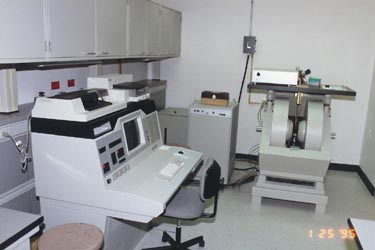Advancing Cancer Research, Tulane Style

Electron Paramagnetic Resonance facility, J. Bennett Johnston Health and Environmental Research Building, Room 318. Photo: January 25, 1995.
|
Why would an institution that promotes itself as a center for cancer research crush a 20-year-old program just as it was positioned to bear fruit — after years of effort to acquire the technical expertise, identify the underlying chemistry, and develop a working model for investigating a unique free-radical mechanism of chemical carcinogenesis?
The EPR spectrometer shown had been purchased by Bernofsky with a 1992 grant for $250,000 from the State of Louisiana Board of Regents [1]. It was delivered on May 31, 1993, but not installed until June 30, 1994. Many obstacles had been imposed by a new department chairman who was determined to exclude Bernofsky's research program from his department and replace him with a faculty member of his own choosing — all sanctioned by Tulane.
Despite mounting hostilities, Bernofsky and Dr. Ratnayake Bandara, a coworker, were able to demonstrate for the first time the presence of hydroxyl and carbon-centered radicals in a line of human monocytic leukemia cells maintained in tissue culture [2].
On August 9, 1994, Bernofsky received notice of his impending termination from the department chairman. Bandara was forced to leave on September 28, 1994, and Bernofsky filed a lawsuit on January 31, 1995.
The next day, February 1, 1995, the Air Force forwarded the long-expected notice that Bernofsky's grant application to conduct free radical research would be funded, with the first payment of the $250,000 award to arrive on April 1, 1995 [3]. The check was received by Tulane and later returned.
Despite his grant awards, the chairman's prior recognition of tenure, and the fact that his annually-renewed academic appointment did not expire until July 1, 1995, Bernofsky was terminated on April 21, 1995.
The EPR facility was closed, the spectrometer dismantled, and the console moved across town to the Chemistry Department, where it was said to be combined with an existing magnet for use in its graduate program.
References
- Contract LEQSF(1992-93)-ENH-TR-34, "Electron Paramagnetic Resonance Spectrometer."
- C. Bernofsky and B.M.R. Bandara, Spin Trapping Endogenous Radicals in MC-1010 Cells: Evidence for Hydroxyl Radical and Carbon-centered Ascorbyl Radical Adducts, Molec. Cell. Biochem., 148, 155-164 (1995).
- United States Air Force, Air Force Office of Scientific Research, Grant No: F49620-95-1-0274, "Radical Intermediates of Haloacetic Acids," Year 1 Funds: $124,921; Year 2 Funds: $124,161.
|